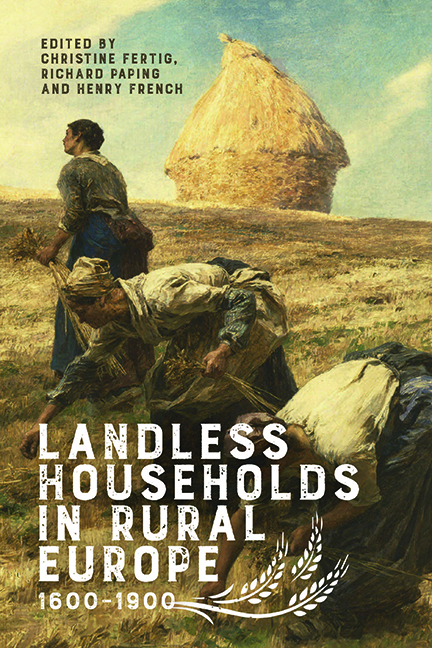Book contents
- Frontmatter
- Contents
- List of Illustrations
- Notes on Contributors
- Preface
- Introduction
- 1 The Treballadors of Girona: Evidence of the Emergence of Wage Labour in Early Modern Catalonia in the Sixteenth and Seventeenth Centuries
- 2 The Squatter Economy of the English Countryside: Building New Landless Communities in England, c. 1600–1900
- 3 The Rise of Landless Households in the Dutch Countryside, c. 1600–1900
- 4 ‘Gaining Ground’ in Flanders after the 1840s: Access to Land and the Coping Mechanisms of Landless and Semi-Landless Households, c. 1850–1900
- 5 Strategies of Survival, Landlessness and Forest Settlement in Flanders: The Forest of Houthulst in a Changing Landscape of Survival (c. 1500–1900)
- 6 Landless and Pauper Households in England, c. 1760–1835: A Comparison of Two Southern English Rural Communities
- 7 Landless Rural Households in France, 1852–1910
- 8 Survival in a Hostile Agrarian Regime: Landless and Semi-Landless Households in Seventeenth-Century Sweden and Finland
- 9 Farming Craftsmen? Access to Land and the Socio-Economic Position of Rural Artisans in Early Modern Finland
- 10 Landlessness and Marriage Restrictions: Tyrol and Vorarlberg in the Eighteenth and Nineteenth Centuries
- 11 Cottages, Barns and Bake Houses: Landless Rural Households in North-Western Germany in the Eighteenth Century
- Bibliography
- Index
- Boydell Studies in Rural History
3 - The Rise of Landless Households in the Dutch Countryside, c. 1600–1900
Published online by Cambridge University Press: 08 October 2022
- Frontmatter
- Contents
- List of Illustrations
- Notes on Contributors
- Preface
- Introduction
- 1 The Treballadors of Girona: Evidence of the Emergence of Wage Labour in Early Modern Catalonia in the Sixteenth and Seventeenth Centuries
- 2 The Squatter Economy of the English Countryside: Building New Landless Communities in England, c. 1600–1900
- 3 The Rise of Landless Households in the Dutch Countryside, c. 1600–1900
- 4 ‘Gaining Ground’ in Flanders after the 1840s: Access to Land and the Coping Mechanisms of Landless and Semi-Landless Households, c. 1850–1900
- 5 Strategies of Survival, Landlessness and Forest Settlement in Flanders: The Forest of Houthulst in a Changing Landscape of Survival (c. 1500–1900)
- 6 Landless and Pauper Households in England, c. 1760–1835: A Comparison of Two Southern English Rural Communities
- 7 Landless Rural Households in France, 1852–1910
- 8 Survival in a Hostile Agrarian Regime: Landless and Semi-Landless Households in Seventeenth-Century Sweden and Finland
- 9 Farming Craftsmen? Access to Land and the Socio-Economic Position of Rural Artisans in Early Modern Finland
- 10 Landlessness and Marriage Restrictions: Tyrol and Vorarlberg in the Eighteenth and Nineteenth Centuries
- 11 Cottages, Barns and Bake Houses: Landless Rural Households in North-Western Germany in the Eighteenth Century
- Bibliography
- Index
- Boydell Studies in Rural History
Summary
In this chapter, I will first sketch out developments in the shares of landless and land-poor rural households in the Netherlands in the nineteenth century after briefly going into changes in the earlier centuries, building on available datasets in the literature. For this analysis, landless and land-poor households can be divided into three categories: (1) farm labourers with hardly any land; (2) very small peasants or cottagers who could not sustain themselves from their holdings; and (3) artisans and others wholly or partially specialised in non-agricultural work. Their importance differed distinctively by region, for instance between coastal and inland parts of the Netherlands.
In the rest of this chapter, I will concentrate on the final quarter of the eighteenth and on the nineteenth century, and on the first group outlined above, of landless unskilled labourers, especially in coastal Groningen and partly also in inland Drenthe, both situated in the north of the Netherlands. Questions that will be answered are: what were the survival strategies over the lifecycle of labouring families? How did their members’ employment opportunities vary according to the seasons in the nineteenth century? What was the social origin of the parents of labourers and what were their children's chances of escaping from the labouring class?
The development of landed and non-landed rural households in the Netherlands, 1600–1900
First, we will briefly sketch the development of the Dutch rural population from the sixteenth century to 1900, followed by a discussion of the development of the rural social structure until 1800. The main part of this section will deal with the rural social structure from about 1800 onwards, when statistical data on rural households becomes relatively more abundant for the Netherlands. The problem, however, is that different definitions must be used to distinguish the different social segments in society. We will look first at the number of households using at least one horse and try to combine them with census-data around 1909 and occupational data around 1807. The use by a rural household of a horse – for which some statistics are available – implies in general that this household has a reasonable amount of land at its disposal, making the possession of a horse necessary to help cultivate it.
- Type
- Chapter
- Information
- Landless Households in Rural Europe, 1600-1900 , pp. 63 - 90Publisher: Boydell & BrewerPrint publication year: 2022

